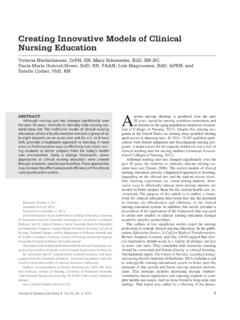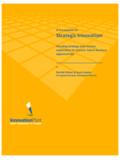Transcription of Using ICT to enable Agricultural Innovation Systems for ...
1 Using ICT to enable Agricultural Innovation Systems for SmallholdersThe World Bank, in collaboration with the e- agriculture community and the Food and agriculture Organization of the United Nations (FAO), is holding a series of two week online forums. These e-forums stem from the launch of the World Bank s ICT in agriculture e-Sourcebook (2011) and the growing demand for knowledge on how to use ICT to improve Agricultural productivity and raise smallholder incomes. The following summary captures the discussion during the most recent e-forum. The text is derived strictly from the participants posts during the forum and does not reflect the views of the World Bank or innovationsThe potential of ICT to support the access to and exchange of information for smallholder farmers is clear.
2 A rich discussion centred on examples of current pilots and processes expected to bring beneficial results. It must be noted, however, that there continues to be a challenge in finding examples that have moved beyond the pilot stage, reaching scale in a sustainable improved communication, ICT are known to enhance or expand human networks. Mobile technology is seen as having a particularly positive impact in this area, fostering networks of farmers and agribusiness, so that they can support each other. Specialized applications are being developed to further extend this impact, including Sustaination ( a LinkedIn for local food and farmers ) in the United a technology perspective, the discussion focused largely, but not exclusively, on Innovation Using mobile phones.
3 Many of these examples use SMS. Reference was made to the report Connected agriculture , which states that the greatest increase to farmers incomes will come from mobile: mobile payment Systems that provide farmers with the ability to exchange capital, mobile information services that give access to critical, targeted information on commodity prices, weather, disease outbreaks, etc., and helpline services providing key tips and real-time has allowed for innovations that bring financial services, including mobile money, to smallholder farmers. Agrinet Uganda, M-PESA in Kenya, and others have brought financial services to the previously unbanked, a critical component of improving smallholders participation in the value service that allows for the authentication of Agricultural inputs is being piloted by CropLife in Uganda.
4 Using scratch labels and SMS, farmers can confirm that an input is genuine at the point of purchase. The scratch label system works like an airtime refill, following a process that is already widely known in agriculture communities. The system also provides a link to the Ministry of agriculture , which has a mandate to stop counterfeit products, and can follow up on any were several other examples of Innovation Using SMS, including Systems such as FrontlineSMS and appli-cations like Twitter, to reach many individuals with advisory information in an efficient and timely manner. The Neil Palmer, CIAT2 Using ICT to enable Agricultural Innovation Systems for Smallholdersattraction of SMS is based on its low cost and ability to work on all types of mobile phones.
5 While SMS-based Systems seem to predominate at this time, there is hope that technology and infrastructure will progress beyond short texts to allow use of more complex information, including radio remains one of the most widespread and well studied ICT, allowing farmers to access infor-mation and for service providers to provide information. Innovation has occurred where new ICT are paired with radio. Combinations such as radio and mobile phones can become an important tool in information exchange and community networking. Reports by Farm Radio International were referenced in the discussion, giving more details on these new communication services.
6 Radio s positive role in reaching female farmers was re-affirmed, along with a need for greater awareness of the gender inequity of different audio-focused ICT Innovation is the Talking Book, a low cost audio computer . It is being used by Literacy Bridge in Agricultural projects to address both literacy and gender gaps by providing women and illiterate farmers, as well as others, with access to information on Agricultural technologies on centres, while around for some time, are also experienc-ing a new round of Innovation . Different models for call centre operation and partnerships are being tested by groups like Esoko and the Grameen Foundation, which in time may provide more guidance on this issue.
7 Lifeline India has implemented an interac-tive voice response (IVR) system with a localized Question and Answer service that now has about 10% of the calls automatically answered. While the value of Systems such as Lifeline s IVR still has to be substantiated, such developments could point the way to sustainable , especially when combined with participatory processes, has shown positive impact on Agricultural training and productivity amongst smallholders. Some processes Using video are focused on dissemination, while others also enhance peer-to-peer learning. The example of Digital Green s Innovation in the processes used for video production came up repeatedly in the discussion.
8 Its innovative processes build on social dynamics that support the development, screening, and learning from the videos. A study has shown that this process is at least ten times more effective on a cost per adoption basis and seven times more likely to encourage farmers to adopt new practices compared to conventional Agricultural extension Systems . Digital Green is also reaching scale, having produced over 2,000 videos in local languages, reaching 110,000 famers in over 1,100 villages in India, with plans to expand into Ethiopia and Using ICT can also be found in more formal learning Systems . The Institute of Agro Technology and Rural Science in Sri Lanka is offering diplomas in agro-technology to the farming community without barriers of age, distance, time and academic background in local languages.
9 This is facilitated through the use of the developed countries, ICT are being tested to reduce animal theft. Technologies such as retinal scanning show promise, but so far are cost was noted that innovations in associated technologies ( solar chargers for power supply) are also critical elements in successful ICT facilitates knowledge generation, documentation, and sharing in support of farmers and of farmer innovationsFarmers are the traditional innovators in agriculture , and actively engage in communication about Innovation . ICT provides a new channel for this communication. The key for development actors is to understand the tradi-tional process of farmer Innovation in order to succeed in bringing ICT in line to support this.
10 Communities them-selves will also drive this through their own choices around technology and its Energy3 Using ICT to enable Agricultural Innovation Systems for SmallholdersSome participants felt that technology must be easy to use, and selected from the start to ensuring that farmers can use it themselves with minimal external support. This was supported by experience showing that farmers learn better from fellow mobile phone and new processes Using video are mentioned as the most popular modern ICT for farmer-to-farmer communication and Innovation sharing, noting that video normally requires the involvement of an inter-mediary. While communication at this level has always existed, and ICT can simply supplement these channels, with increased communication there is a much greater need for individuals ( extension agents, interme-diaries) to validate and further disseminate the information, and support its documentation is at a point in the Innovation process where ICT can be effectively used to document Innovation processes and generate knowledge, especially local Agricultural content.
















